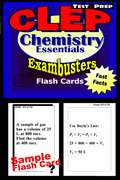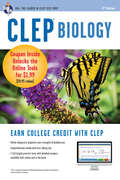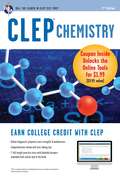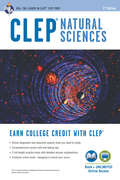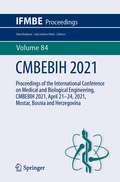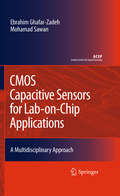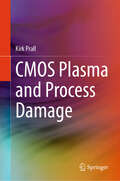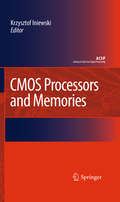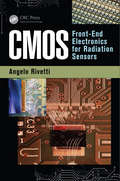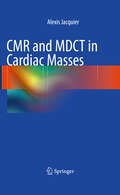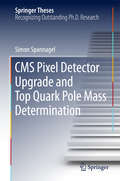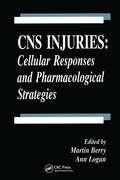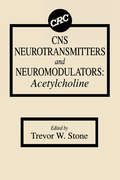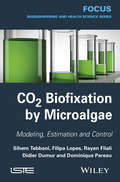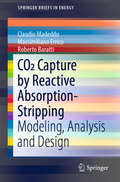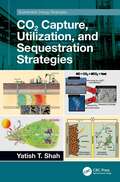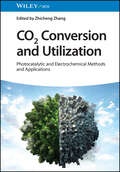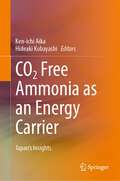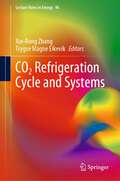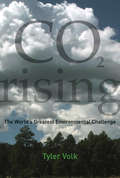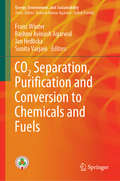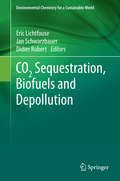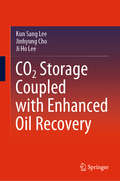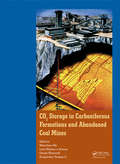- Table View
- List View
CLEP Test Prep Review Flash Cards: Chemistry Essentials (Exambusters CLEP Workbook #2)
by Ace Inc.<P><P><i>Advisory: Bookshare has learned that this book offers only partial accessibility. We have kept it in the collection because it is useful for some of our members. Benetech is actively working on projects to improve accessibility issues such as these.</i><P><P> 700 questions and answers. Essential definitions, formulas, concepts, and sample problems. <P><P>Topics: Introduction, Matter, Atoms, Formulas, Moles, Reactions, Elements, Periodic Table, Electrons, Chemical Bonds, Heat, Gases, Phase Changes, Solutions, Reaction Rates, Equilibrium, Acids and Bases, Oxidation and Reduction, Introduction to Organic Chemistry, Radioactivity <P> EXAMBUSTERS CLEP Prep Workbooks provide comprehensive CLEP review--one fact at a time--to prepare students to take practice CLEP tests. Each CLEP study guide focuses on fundamental concepts and definitions--a basic overview to begin studying for the CLEP exam. Up to 600 questions and answers, each volume in the CLEP series is a quick and easy, focused read. Reviewing CLEP flash cards is the first step toward more confident CLEP preparation and ultimately, higher CLEP exam scores!
CLEP® Biology Book + Online (CLEP Test Preparation)
by Laurie Ann CallihanEarn College Credit with REA’s Test Prep for CLEP Biology Everything you need to pass the exam and get the college credit you deserve. REA leads the way in helping students pass their College Board CLEP exams and earn college credit while reducing their tuition costs. With 25+ years of experience in test prep for the College-Level Examination Program (CLEP), REA is your trusted source for the most up-to-date test-aligned content. Whether you’re an adult returning to finish your degree, a traditional-age college student, a military service member, or a high school or home-schooled student looking to get a head start on college and shorten your path to graduation, CLEP is perfect for you. REA’s expert authors know the CLEP tests inside out. And thanks to our partners at Proctortrack (proctortrack.com/clep), you can now take your exam at your convenience, from the comfort of home. Prep for success on the CLEP Biology exam with REA’s personalized three-step plan: (1) focus your study, (2) review with the book, and (3) measure your test-readiness. Our Book + Online prep gives you all the tools you need to make the most of your study time: Diagnostic exam: Pinpoint what you already know and what you need to study.Targeted subject review: Learn what you’ll be tested on.Two full-length practice exams: Zero in on the topics that give you trouble now so you’ll be confident and prepared on test day.Glossary of key terms: Round out your prep with must-know vocabulary.REA is America’s recognized leader in CLEP preparation. Our test prep helps you earn valuable college credit, save on tuition, and accelerate your path to a college degree.
CLEP® Chemistry Book + Online (CLEP Test Preparation)
by Kevin R. ReelEarn College Credit with REA’s Test Prep for CLEP Chemistry Everything you need to pass the exam and get the college credit you deserve. REA leads the way in helping students pass their College Board CLEP exams and earn college credit while reducing their tuition costs. With 25+ years of experience in test prep for the College-Level Examination Program (CLEP), REA is your trusted source for the most up-to-date test-aligned content. Whether you’re an adult returning to finish your degree, a traditional-age college student, a military service member, or a high school or home-schooled student looking to get a head start on college and shorten your path to graduation, CLEP is perfect for you. REA’s expert authors know the CLEP tests inside out. And thanks to our partners at Proctortrack (proctortrack.com/clep), you can now take your exam at your convenience, from the comfort of home. Prep for success on the CLEP Chemistry exam with REA’s personalized three-step plan: (1) focus your study, (2) review with the book, and (3) measure your test-readiness. Our Book + Online prep gives you all the tools you need to make the most of your study time: Diagnostic exam: Pinpoint what you already know and what you need to study.Targeted subject review: Learn what you’ll be tested on.Two full-length practice exams: Zero in on the topics that give you trouble now so you’ll be confident and prepared on test day.Glossary of key terms: Round out your prep with must-know vocabulary.REA is America’s recognized leader in CLEP preparation. Our test prep helps you earn valuable college credit, save on tuition, and accelerate your path to a college degree.
CLEP® Natural Sciences Book + Online (CLEP Test Preparation)
by David Callihan Laurie Ann CallihanEarn College Credit with REA’s Test Prep for CLEP Natural Sciences Everything you need to pass the exam and get the college credit you deserve. REA leads the way in helping students pass their College Board CLEP exams and earn college credit while reducing their tuition costs. With 25+ years of experience in test prep for the College-Level Examination Program (CLEP), REA is your trusted source for the most up-to-date test-aligned content. Whether you’re an adult returning to finish your degree, a traditional-age college student, a military service member, or a high school or home-schooled student looking to get a head start on college and shorten your path to graduation, CLEP is perfect for you. REA’s expert authors know the CLEP tests inside out. And thanks to our partners at Proctortrack (proctortrack.com/clep), you can now take your exam at your convenience, from the comfort of home. Prep for success on the CLEP Natural Sciences exam with REA’s personalized three-step plan: (1) focus your study, (2) review with the book, and (3) measure your test-readiness. Our Book + Online prep gives you all the tools you need to make the most of your study time: Diagnostic exam: Pinpoint what you already know and what you need to study.Targeted subject review: Learn what you’ll be tested on.Two full-length practice exams: Zero in on the topics that give you trouble now so you’ll be confident and prepared on test day.Glossary of key terms: Round out your prep with must-know vocabulary.REA is America’s recognized leader in CLEP preparation. Our test prep helps you earn valuable college credit, save on tuition, and accelerate your path to a college degree.
CMBEBIH 2021: Proceedings of the International Conference on Medical and Biological Engineering, CMBEBIH 2021, April 21–24, 2021, Mostar, Bosnia and Herzegovina (IFMBE Proceedings #84)
by Almir Badnjevic Lejla Gurbeta PokvićThis book presents cutting-edge research and developments in the field of medical and biological engineering. It gathers the proceedings of the International Conference on Medical and Biological Engineering, CMBEBIH 2021, held partly virtually, partly physically, on April 21–24, 2021, from and in Mostar, Bosnia and Herzegovina. Focusing on the goal to ‘Stay Focused’, contributions report on both basic and applied research in a wide range of related fields, such as biomedical signal processing, medical physics and imaging, biosensors and micro/nanotechnologies, biomaterials, biomechanics and robotics, cardiorespiratory, endocrine and neural systems engineering. Novel models, methods and technologies for bio- and health informatics, as well as applications of machine learning and AI in health care, and advances in genetic engineering are also highlighted. All in all, this book provides academics and professionals with novel, practical solutions to solve the current problems in biomedical research and applications, and a source of inspiration for improving medicine and health care in the future.
CMOS Capacitive Sensors for Lab-on-Chip Applications: A Multidisciplinary Approach (Analog Circuits and Signal Processing)
by Mohamad Sawan Ebrahim Ghafar-ZadehThe main components of CMOS capacitive biosensors including sensing electrodes, bio-functionalized sensing layer, interface circuitries and microfluidic packaging are verbosely explained in chapters 2-6 after a brief introduction on CMOS based LoCs in Chapter 1. CMOS Capacitive Sensors for Lab-on-Chip Applications is written in a simple pedagogical way. It emphasises practical aspects of fully integrated CMOS biosensors rather than mathematical calculations and theoretical details. By using CMOS Capacitive Sensors for Lab-on-Chip Applications, the reader will have circuit design methodologies, main important biological capacitive interfaces and the required microfluidic fabrication procedures to create capacitive biosensor through standard CMOS process.
CMOS Plasma and Process Damage
by Kirk PrallThis book discusses the complex technology of building CMOS computer chips and covers some of the unusual problems that can occur during chip manufacturing. Readers will learn how plasma and process damage results from the high-energy processes that are used in chip manufacturing, causing harm to the chips, functional failure and reliability problems.
CMOS Processors and Memories (Analog Circuits and Signal Processing)
by Krzysztof IniewskiCMOS Processors and Memories addresses the-state-of-the-art in integrated circuit design in the context of emerging computing systems. New design opportunities in memories and processor are discussed. Emerging materials that can take system performance beyond standard CMOS, like carbon nanotubes, graphene, ferroelectrics and tunnel junctions are explored. CMOS Processors and Memories is divided into two parts: processors and memories. In the first part we start with high performance, low power processor design, followed by a chapter on multi-core processing. They both represent state-of-the-art concepts in current computing industry. The third chapter deals with asynchronous design that still carries lots of promise for future computing needs. At the end we present a "hardware design space exploration" methodology for implementing and analyzing the hardware for the Bayesian inference framework. This particular methodology involves: analyzing the computational cost and exploring candidate hardware components, proposing various custom architectures using both traditional CMOS and hybrid nanotechnology CMOL. The first part concludes with hybrid CMOS-Nano architectures. The second, memory part covers state-of-the-art SRAM, DRAM, and flash memories as well as emerging device concepts. Semiconductor memory is a good example of the full custom design that applies various analog and logic circuits to utilize the memory cell's device physics. Critical physical effects that include tunneling, hot electron injection, charge trapping (Flash memory) are discussed in detail. Emerging memories like FRAM, PRAM and ReRAM that depend on magnetization, electron spin alignment, ferroelectric effect, built-in potential well, quantum effects, and thermal melting are also described. CMOS Processors and Memories is a must for anyone serious about circuit design for future computing technologies. The book is written by top notch international experts in industry and academia. It can be used in graduate course curriculum.
CMOS: Front-End Electronics for Radiation Sensors (Devices, Circuits, and Systems #42)
by Angelo RivettiCMOS: Front-End Electronics for Radiation Sensors offers a comprehensive introduction to integrated front-end electronics for radiation detectors, focusing on devices that capture individual particles or photons and are used in nuclear and high energy physics, space instrumentation, medical physics, homeland security, and related fields. Emphasizing practical design and implementation, this book: Covers the fundamental principles of signal processing for radiation detectors Discusses the relevant analog building blocks used in the front-end electronics Employs systematically weak and moderate inversion regimes in circuit analysis Makes complex topics such as noise and circuit-weighting functions more accessible Includes numerical examples where appropriate CMOS: Front-End Electronics for Radiation Sensors provides specialized knowledge previously obtained only through the study of multiple technical and scientific papers. It is an ideal text for students of physics and electronics engineering, as well as a useful reference for experienced practitioners.
CMR and MDCT in Cardiac Masses
by Alexis JacquierThis book, unique in focusing specifically on cardiac masses, is the result of cooperation among a number of teams of radiologists working under the aegis of the French Society of Cardiovascular Imaging (SFICV). Its goal is to review the different CMR sequences and CT acquisition protocols used to explore cardiac masses, highlighting their diagnostic capabilities. It has been designed as a teaching tool and offers a fully illustrated compendium of clinical cases, tables summarizing data, and decision-making trees essential in everyday practice. It is presented as a practical handbook and can be either read cover to cover or consulted whenever needed during a cardiac imaging assignment. The book is intended for all students and experienced practitioners, whether radiologists or not, who are interested in cardiac or thoracic pathology.
CMS Pixel Detector Upgrade and Top Quark Pole Mass Determination (Springer Theses)
by Simon SpannagelThis thesis addresses two different topics, both vital for implementing modern high-energy physics experiments: detector development and data analysis. Providing a concise introduction to both the standard model of particle physics and the basic principles of semiconductor tracking detectors, it presents the first measurement of the top quark pole mass from the differential cross-section of tt+J events in the dileptonic tt decay channel. The first part focuses on the development and characterization of silicon pixel detectors. To account for the expected increase in luminosity of the Large Hadron Collider (LHC), the pixel detector of the compact muon solenoid (CMS) experiment is replaced by an upgraded detector with new front-end electronics. It presents comprehensive test beam studies conducted to verify the design and quantify the performance of the new front-end in terms of tracking efficiency and spatial resolution. Furthermore, it proposes a new cluster interpolation method, which utilizes the third central moment of the cluster charge distribution to improve the position resolution. The second part of the thesis introduces an alternative measurement of the top quark mass from the normalized differential production cross-sections of dileptonic top quark pair events with an additional jet. The energy measurement is 8TeV. Using theoretical predictions at next-to-leading order in perturbative Quantum Chromodynamics (QCD), the top quark pole mass is determined using a template fit method.
CNS Drug Development and Delivery: Concepts and Applications (AAPS Introductions in the Pharmaceutical Sciences #9999)
by Alan TaleviThe book covers recent advances in the field of CNS therapeutics, including opportunities posed by expanding basic knowledge related to CNS conditions and novel approaches for efficient drug delivery to the brain (e.g., pharmaceutical nanocarriers and transporter- and transcytosis-mediated drug delivery to the brain inhibition of the blood-brain barrier). Chapters dealing with state-of-the-art in silico and in vitro tools for predictive purposes related to CNS bioavailability are also be included. This is an ideal book for undergraduate students and graduates in the field of medicine and pharmaceutics, and professionals working in the field of brain disorders.
CNS Injuries: Cellular Responses and Pharmacological Strategies
by Martin BerryThe basic science of the cellular and molecular responses of the brain to injury is a rapidly expanding area of research that provides evidence of growing opportunities for pharmacological intervention in the clinic. CNS Injuries: Cellular Responses and Pharmacological Strategies is an examination of developments in our understanding of the cellular and trophic responses to CNS injuries and the potential treatment. This text collates reviews of the most important areas of study regarding injury response including inflammatory and immune reactions scarring neuron death demyelination and remyelination axonal regeneration re-establishment of neuronal connectivity Providing a record of recent advances that will help point the way to future developments, this enlightening reference is sure to benefit researchers and practitioners in a broad range of disciplines, including: neurology, pharmacology, pathology, toxicology, immunology, and many others.
CNS Neurotransmitters and Neuromodulators: Acetylcholine
by Trevor W. StoneThe series CNS Neurotransmitters and Neuromodulators is destined to be the definitive reference work on the physiology and pharmacology of the central nervous system. Written by an outstanding group of international authors, chapters cover a wide range of interdisciplinary aspects of the subject. This first volume includes an in-depth examination of acetylcholine, ranging from the localization of synthetic enzymes through electrophysiology, pharmacology, and molecular biology to behavioral importance in learning and memory. This indispensable and comprehensive reference keeps you abreast of new developments in several areas of neuroscience.
CO2 Biofixation by Microalgae: Modeling, Estimation and Control
by Didier Dumur Sihem Tebbani Rayen Filali Dominique Pareau Filipa LopesDue to the consequences of globa l warming and significant greenhouse gas emissions, several ideas have been studied to reduce these emissions or to suggest solut ions for pollutant remov al. The most promising ideas are reduced consumption, waste recovery and waste treatment by biological systems. In this latter category, studies have demonstrated that the use of microalgae is a very promising solution for the biofixation of carbon dioxide. In fact, these micro-organisms are able to offset high levels of CO2 thanks to photosynthesis. Microalgae are also used in various fields (food industry, fertilizers, biofuel, etc.). To obtain a n optimal C O2 sequestration us ing micr oal gae, their cul tivatio n has to be c arried ou t in a f avorable e nvironment, corresponding to optimal operating conditions (temperature, nutrients, pH, light, etc.). Therefore, microalgae are grown in an enclosure, i.e. photobioreactors, which notably operate in continuous mode. This type of closed reactor notably enables us to reduce culture contamination, to improve CO2 transfer and to better control the cultivation system. This last point involves the regulation of concentrations (biomass, substrate or by-product) in addition to conventional regulations (pH, temperature).To do this, we have to establish a model of the system and to identify its parameters; to put in place estimators in order to rebuild variables that are not measured online (software sensor); and finally to implement a control law, in order to maintain the system in optimal conditions despite modeling errors and environmental disturbances that can have an influence on the system (pH variations, temperature, light, biofilm appearance, etc.).
CO2 Capture by Reactive Absorption-Stripping: Modeling, Analysis and Design (SpringerBriefs in Energy)
by Claudio Madeddu Massimiliano Errico Roberto BarattiThis book focuses on modelling issues and their implications for the correct design of reactive absorption–desorption systems. In addition, it addresses the case of carbon dioxide (CO2) post-combustion capture in detail. The book proposes a new perspective on these systems, and provides technological solutions with comparisons to previous treatments of the subject. The model that is proposed is subsequently validated using experimental data. In addition, the book features graphs to guide readers with immediate visualizations of the benefits of the methodology proposed. It shows a systematic procedure for the steady-state model-based design of a CO2 post-combustion capture plant that employs reactive absorption-stripping, using monoethanolamine as the solvent. It also discusses the minimization of energy consumption, both through the modification of the plant flowsheet and the set-up of the operating parameters. The book offers a unique source of information for researchers and practitioners alike, as it also includes an economic analysis of the complete plant. Further, it will be of interest to all academics and students whose work involves reactive absorption-stripping design and the modelling of reactive absorption-stripping systems.
CO2 Capture, Utilization, and Sequestration Strategies (Sustainable Energy Strategies)
by Yatish T. ShahOffering practical treatment strategies for CO2 emission generated from various energy-related sources, CO2 Capture, Utilization, and Sequestration Strategies emphasizes carbon capture, utilization, and sequestration (CCUS) with special focus on methods for each component of the strategy. While other books mostly focus on CCS strategy for CO2, this book details the technologies available for utilization of CO2, showing how it can be a valuable renewable source for chemicals, materials, fuels, and power instead of a waste material damaging the environment. Highlights current and potential future commercially viable CCUS strategies Discusses applications for direct and the more complex indirect utilization of CO2 streams Examines viability of the mineral carbonation process and biological treatments to convert CO2 into useful biochemicals, biomaterials, and biofuels Explores heterogeneous catalysis for thermal and electrochemical conversion and solar energy-based thermal, photo-thermal, and photocatalytic conversion of CO2 Presents the rapidly growing concept of plasma-activated catalysis for CO2 conversion CO2 Capture, Utilization, and Sequestration Strategies is a valuable reference for researchers in academia, industry, and government organizations seeking a guide to effective CCUS processes, technologies, and applications.
CO2 Conversion and Utilization: Photocatalytic and Electrochemical Methods and Applications
by Zhicheng ZhangCO2 Conversion and Utilization Comprehensive overview of current development of various catalysts in CO2 conversion and utilization through photocatalytic and electrochemical methods CO2 Conversion and Utilization systematically summarizes the development of CO2 photo- and electro-conversion and utilization, especially the reaction mechanism, engineering and technology of testing, and preparation methods and physicochemical properties of various catalytic materials. The rational design and preparation of catalysts, development of characterization technologies, and in-depth understanding of catalytic mechanisms are systematically discussed. In particular, the various parameters influencing the photocatalytic and electrochemical CO2 reduction are emphasized. The underlying challenges and perspectives for the future development of efficient catalysts for CO2 reduction to specific chemicals and fuels are discussed at the end of the text. Written by a highly qualified author with significant experience in the field, CO2 Conversion and Utilization includes information on: Measurement systems and parameters for CO2 photo/electro-conversion, CO2 photo/electro-conversion mechanism, and Cu-based and Cu-free metal materials for electrocatalytic CO2 reduction Organic-inorganic, metal organic framework, and covalent organic framework hybrid materials for CO2 photo/electro-conversion Single/dual-atom catalysts, homogeneous catalysts, and high-entropy alloys for CO2 photo/electro-conversion Semiconductor composite and carbon-based materials for photocatalytic CO2 reduction, novel routes for CO2 utilization via metal-CO2 batteries, and CO2 conversion into long-chain compounds Providing comprehensive coverage of the subject, CO2 Conversion and Utilization is of high interest for scientific researchers as well as engineers and technicians in industry, including but not limited to photochemists, electrochemists, environmental chemists, catalytic chemists, chemists in industry, and inorganic chemists.
CO2 Free Ammonia as an Energy Carrier: Japan's Insights
by Ken-Ichi Aika Hideaki KobayashiThis book describes important findings in intensive studies conducted in Japan on ammonia as an energy carrier. It illustrates an advanced solar-heat capture system and storage materials at 600°C and hydrogen production with SOECs and a new IS method through the use of heat. New industrial ammonia catalysts and a demonstration process that started running in Fukushima are also introduced. Advanced ammonia decomposition catalysts and the process that were developed for use by the hydrogen station are presented. An advanced direct ammonia fuel cell was developed and the base data are shown. The book explains that ammonia is used as a fuel for industrial applications because its burning can be controlled without emitting extra NOx in the gas turbine and the real coal co-fired power plant. These breakthroughs have made a strong impact in the world as a practical technology for CO2 reduction. Also provided here are the scientific and industrial backgrounds as well as the environmental assessment and economic evaluation for the future.This book will be helpful for all who are interested in energy technology—researchers, students, and strategy planners at companies and in the government.
CO2 Refrigeration Cycle and Systems (Lecture Notes in Energy #96)
by Xin-Rong Zhang Trygve Magne EikevikThis book covers the fundamentals and applications of carbon dioxide vapor compression refrigeration thermodynamic cycles. In particular, it presents new application areas, such as making ice and snow in the Winter Olympic Games, food cooling and refrigeration. The book explores the physical and chemical characteristics of CO2 fluid, and the unique traits of its thermodynamic cycle. The contributors explain how CO2 refrigeration is a developing, eco-friendly technology, and emphasize its importance for refrigeration and air-conditioning in the current and future market.This book is a valuable source of information for researchers, engineers and policy makers looking to expand their applicable knowledge of high-potential refrigeration technology using carbon dioxide. It is also of interest to postgraduate students and practitioners looking for an academic insight into the industry’s latest eco-friendly technologies.
CO2 Rising: The World's Greatest Environmental Challenge (The\mit Press Ser.)
by Tyler VolkAn introduction to the global carbon cycle and the human-caused disturbances to it that are at the heart of global warming and climate change.The most colossal environmental disturbance in human history is under way. Ever-rising levels of the potent greenhouse gas carbon dioxide (CO2) are altering the cycles of matter and life and interfering with the Earth's natural cooling process. Melting Arctic ice and mountain glaciers are just the first relatively mild symptoms of what will result from this disruption of the planetary energy balance. In CO2 Rising, scientist Tyler Volk explains the process at the heart of global warming and climate change: the global carbon cycle. Vividly and concisely, Volk describes what happens when CO2 is released by the combustion of fossil fuels (coal, oil, and natural gas), letting loose carbon atoms once trapped deep underground into the interwoven web of air, water, and soil. To demonstrate how the carbon cycle works, Volk traces the paths that carbon atoms take during their global circuits. Showing us the carbon cycle from a carbon atom's viewpoint, he follows one carbon atom into a leaf of barley and then into an alcohol molecule in a glass of beer, through the human bloodstream, and then back into the air. He also compares the fluxes of carbon brought into the biosphere naturally against those created by the combustion of fossil fuels and explains why the latter are responsible for rising temperatures. Knowledge about the global carbon cycle and the huge disturbances that human activity produces in it will equip us to consider the hard questions that Volk raises in the second half of CO2 Rising: projections of future levels of CO2; which energy systems and processes (solar, wind, nuclear, carbon sequestration?) will power civilization in the future; the relationships among the wealth of nations, energy use, and CO2 emissions; and global equity in per capita emissions. Answering these questions will indeed be our greatest environmental challenge.
CO2 Separation, Purification and Conversion to Chemicals and Fuels
by Franz Winter Rashmi Avinash Agarwal Jan Hrdlicka Sunita VarjaniThis book presents the recent research on the separation, purification and downstream utilization of CO2 and other flue gases. Chapters include a detailed discussion on the purification and further conversion of CO2 to commodity chemicals and fuels. With contributions from renowned researchers in the field, the book focuses on the current challenges of catalytic high-pressure chemical conversion and biochemical conversion into high-value products. This book is of interest to researchers, professionals, and students working on carbon capture and sequestration, and is a valuable resource for policy makers and government agents working on guidelines and frameworks for carbon capture and reuse.
CO2 Sequestration, Biofuels and Depollution (Environmental Chemistry for a Sustainable World #5)
by Eric Lichtfouse Jan Schwarzbauer Didier RobertWater is the driving force of all nature. This old quote from Leonardo da Vinci reminds us that without water life is simply not possible. As a consequence, water is probably the most important wealth for humanity. In spite of this, drinking water is still polluted by man-made toxicals gathered by waters in soils and the atmosphere. This book presents advanced methods to clean water and air. Chapters also focus on biofuels, greenhouse gases and genetically modified crops.
CO2 Storage Coupled with Enhanced Oil Recovery
by Kun Sang Lee Jinhyung Cho Ji Ho LeeThis book provides a comprehensive and detailed description of the various mechanisms of the CCS–EOR process. Whereas previous texts have primarily focused on carbon capture and storage (CCS) and enhanced oil recovery (EOR) separately, this book provides a general overview of both technologies when used together. Coupled CCS–EOR technology has become increasingly important, as it overcomes the respective shortcomings of the two technologies. The book presents an integrated numerical model including the hysteresis effect, solubility trapping, miscibility, and formation damage by asphaltene deposition. The experimental and model-based evaluation of fluid properties is also discussed. The book concludes by discussing the latest research into CO2 storage coupled with EOR, most notably performance control by including additives in CO2 injection, and CO2 injection into shale reservoirs. Ideally suited for graduate students and researchers in the fields of carbon capture, utilisation, and storage, the book shares essential insights into maximising the efficiency of CCS and EOR alike.
CO2 Storage in Carboniferous Formations and Abandoned Coal Mines
by Manchao He Luis Ribeiro e Sousa Derek Elsworth Euripedes VargasUnderground geological storage of carbon dioxide (CO2) has considerable potential for mitigating climate change. CO2 can be safely injected and stored at well characterized and properly managed sites. Injecting carbon dioxide in deep geological formations can store it underground for long periods of time. Depleted oil and gas reservoirs, saline aqu
